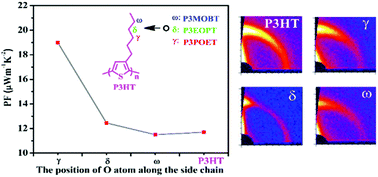Fine-tuning the solid-state ordering and thermoelectric performance of regioregular P3HT analogues by sequential oxygen-substitution of carbon atoms along the alkyl side chains†
Abstract
Conjugated polymers in thin films tend to orient their backbones with respect to substrates through self-assembly when processed from a solution. The molecular packing orientation and crystallinity of polymer crystals have been found to play a critical role in terms of their electrical performance. Taking advantage of the shorter bond length and the smaller rotation energy of the CH2–O bond than those of the CH2–CH2 bond in an alkyl chain, a side-chain engineering strategy is reported, which involves sequential oxygen-substitution of the carbon atoms from the γ position outwards along the hexyls in regioregular poly(3-hexylthiophene) (RR-P3HT). The subtle disparity between the CH2–O and CH2–CH2 bonds is found to enable fine tuning of the solid-state organization of the corresponding RR-P3HT analogues, namely poly(3-(2-propoxyethyl)thiophene) (P3POET), poly(3-(3-ethoxypropyl)thiophene) (P3EOPT) and poly(3-(4-methoxybutyl)thiophene) (P3MOBT). The evolution of film microstructures is observed when doping with FeCl3 in nitromethane at room temperature, and so is their thermoelectric performance. The highest power factor of 19 μW m−1 K−2 was observed for the doped P3POET film, which presents a dominant edge-on orientation with the strongest crystallinity and the closest π–π stacking. At the doping time corresponding to the optimized power factors (PFs) for each polymer, the doped P3POET film maintains both relatively high Seebeck coefficient (S) and electrical conductivity (σ) close to their maximum values, while the other polymers show either higher S and much lower σ (P3HT) or higher σ but much lower S (P3EOPT and P3MOBT). The square dependence of the PFs on S together with higher σ amplifies the power factor value of P3POET, which is almost 2 times those of the other polymers (11–13 μW m−1 K−2).



 Please wait while we load your content...
Please wait while we load your content...